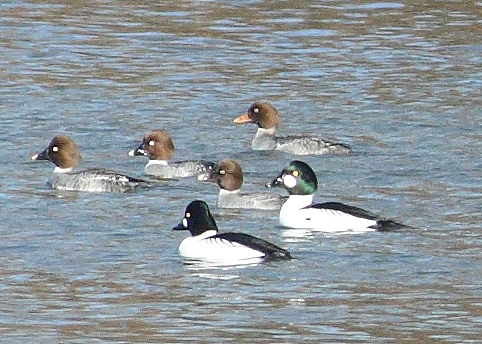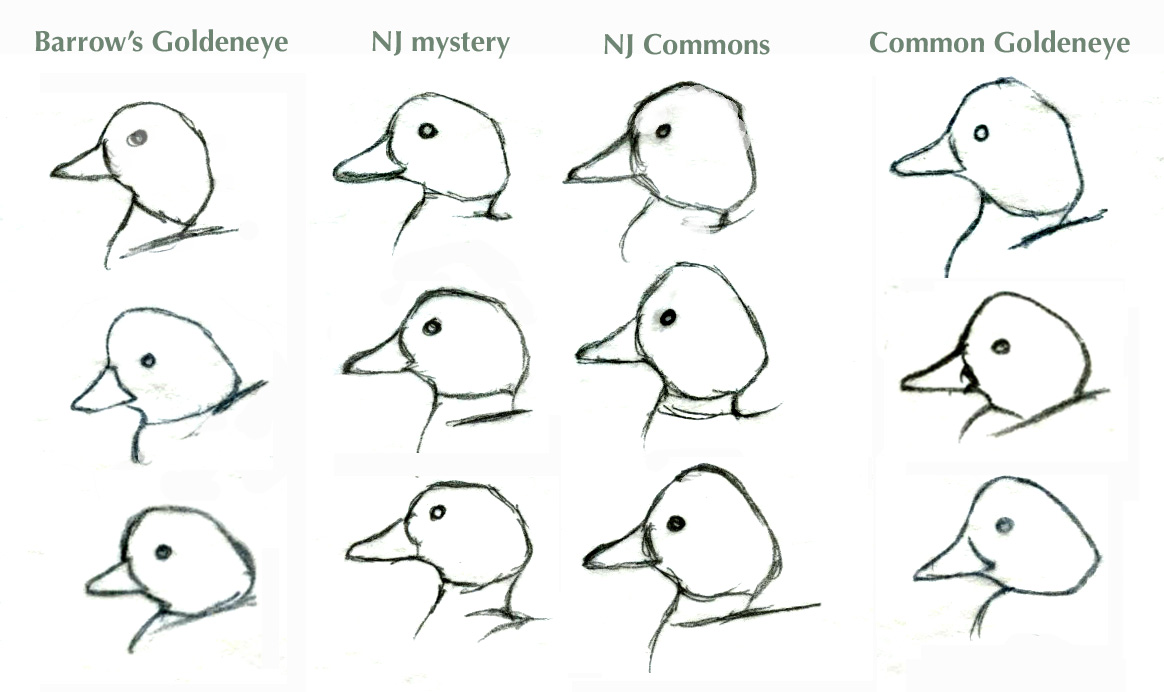Distinguishing Common and Barrow’s Goldeneyes is always a challenge, and particularly so when the bird is a female. One of the most conspicuous and easily judged differences is bill color – Common Goldeneye has a black bill with a small yellowish patch at the tip, while Barrow’s has the bill almost entirely orange-yellow. This works over 99% of the time, but a small percentage of winter females show the bill pattern of the other species (both species have dark dusky bills in summer).
In most parts of North America Barrow’s is the less common, more sought-after, species, so the occasional female Common with a mostly yellow bill puts the “possible rare bird” process in motion. A recent example, from New Jersey in Jan 2010, is shown here:

Expert comments on this bird posted to the NJBirds and ID-Frontiers listservers were quick to point out that it does not show the typical head and bill shape of Barrow’s Goldeneye, and therefore it must be a yellow-billed Common Goldeneye. I agree that it’s not a typical Barrow’s Goldeneye, but we shouldn’t be too quick to rule out the possibility of a hybrid.
These two species of goldeneyes are known to hybridize, with one or more hybrid males being identified nearly every winter somewhere in eastern North America. Strangely, hybrids are much less frequent in the west, even though Barrow’s is far more numerous there. There is one specimen record of a presumed hybrid female, but as far as I know none has ever been identified in the field. They must be occurring at roughly the same rate as males, but the identification is so difficult that it would be virtually impossible to identify a hybrid female with any confidence.
That said, this New Jersey female looks like a good candidate. I’ve traced the head profiles shown in several of Tom Beattie’s photos, and compared those with tracings of Barrow’s and Common Goldeneyes from other photos, and the NJ bird appears to be intermediate between the two species.

It’s probably not safe to call it a hybrid, and most yellow-billed “Common-like” goldeneyes are probably just Commons, but in all of these cases it’s impossible to rule out the possibility of hybrids, and especially here when the bird seems to show some other intermediate features.


Dear David/All,
I agree with David that a hybrid origin cannot be ruled out for the orange-billed NJ Goldeneye (we’ve had a couple like this in Texas), however i remain somewhat confused and cautious about interpreting head shape – largely due to a personal lack of extensive exposure to large numbers of Goldeneyes, especially Barrow’s. I wonder to what degree apparent bill size/shape can be used, regardless of actual bill color?
I’d really appreciate feedback on this bird from the UK – where Barrow’s is a Mega-rarity:
http://www.martinreid.com/Main%20website/goldeneye.html
– because to me it appears not to be a pure Common… but can it’s ID be narrowed-down any further?
Thanks in advance,
Martin
Hi Martin, These species are so difficult to identify from just a few photos, and especially without clear profile views and without other birds in direct comparison. In addition, European Common Goldeneyes are a different subspecies with smaller bills and presumably other subtle differences in head shape compared to American birds. The Barrow’s that I’ve seen with small yellow bands on th bill, including a photo from Iceland, have the yellow extending back below the nostril. The well-defined small band shown here is typical of Common, and I’m not sure how often Icelandic birds look like this. Given all that, I can’t see anything in your photos that suggests it’s not a Common.
I can’t see much that is intermediate about the NJ bird’s head shape in the population sense. If you look at large flocks (bigger samples) of Common Goldeneyes you’ll see considerable subtle variations in head shapes. I’d expect a hybrid to show intermediate bill coloration, not all yellow. The bill size and shape are typical of Common Goldeneye, not intermediate. The head color is at the pale end for Common, not intermediate.
The NJ bird is very similar to many of the yellow-billed Common Goldeneyes I’ve seen over the years in Ontario and Quebec. This variant has been known for over 60 years, but has received very little attention in the literature. Kortright (1942) mentions a female taken near Toronto in early November 1941 with an “all-yellow” bill. Because yellow-billed goldeneyes were being identified as Barrow’s based solely on bill color, we published an ID article with illustrations in Ontario Birds 15(2):81-85, 1997. Link to pdf.
http://www.jeaniron.ca/2010/FemaleGoldeneyes.pdf
Ron Pittaway
Minden, Ontario
Pingback: uberVU - social comments
My experience in Ontario and Quebec is similar to Tony Leukering’s. We haven’t seen any yellow-billed female goldeneyes suspected of being hybrids. Female hybrids are harder to detect, but there may be another reason why they are under-reported, because in some hybrid bird combinations males greatly outnumber females.
Ron Pittaway
Minden ON
At 04:04 PM 1/15/2010, greatgrayowl@AOL.COM wrote:
All:
I noted the following in my original post to the NJ listserver, but in my 14 years in CO, I saw some 12-14 yellow-billed (or mostly yellow-billed) female Common Goldeneyes (COGO). All of these were noted in winter after the Common Goldeneyes had arrived and were, presumably, all adults (eye color, bill color). (Note that Barrow’s Goldeneye (BAGO) is a permanent resident in the state and I saw 20-100 in most years.) In that time, I saw some 4-5 male hybrid goldeneyes. Every yellow-billed COGO that I saw looked precisely like an adult female COGO, except for the bill color. I fully understand that mixing genes in waterfowl can produce some very odd results, but I just cannot believe that that many “female hybrid goldeneye” could all look just like COGOs, except for the bill color; bill shape and size and head shape were all well within range of female COGO and outside the parameters for female BAGO. I just don’t see any need to require BAGO genes to explain the NJ goldeneye. Yes, they’re rare, but they exist, at least in Colorado and Ontario.
Respectfully,
Tony Leukering
Villas, NJ
I’ve taken a few looks through the slideshow of the NJ goldeneye and I agree with David that this bird’s head shape is consistently intermediate between Common and Barrow’s through all images. On the other hand, I have trouble seeing the bill shape as anything outside the range of Common. If a pure Common, what are the odds this particular yellow-billed individual would be the one in the flock to sport such ‘fringe’ head shape? I think this is a decent candidate for a hybrid and, at the least, should be left unidentified.
But the real reason I’m commenting here is just to point how out fascinating it is that several experienced folks can look at the same images and come to different conclusions. Oh the perils of photography. Nothing beats seeing birds in real life…
Thanks for all the comments. And I agree entirely with Nick Bonomo.
After being engrossed in goldeneyes for a week I’ve posted a comprehensive review of identification of female goldeneyes here
I still think the NJ goldeneye is odd enough to be called “unidentified”. It may just be a Common, but I don’t think it can be identified unless someone gets more and better photos and detailed study. To summarize:
The yellow bill is very rare on adult Commons (and this is an adult based on wing pattern) so it makes a good starting point to consider that the bird may not be a Common.
The head shape is odd, and is consistently slightly un-Common-like across all of the photos
The bill seems long for Barrow’s, but appears very stout, which could represent some Barrow’s influence, or this may be the result of camera effects (digital cameras “favor” light colors over black, so the size of the bill might be inflated by the camera sensor)
Head color is variable in the photos, darker than the Commons in some, paler in others
Wing pattern is not helpful either way, the amount of white could be on the small side for Common, but is not obviously so.
A very interesting bird.
Hi David,
It’s been a contining education for me to read the recent messages about hybrid goldeneyes. We have a regular winter flock of some 100-200 Common Goldeneyes that winter at Sandy Hook, and for the last decade there have typically been one or two female and formerly one male Barrow’s wintering at the site. The recent images posted of two female Barrow’s at Sandy Hook and the second “mystery goldeneye” on the Delaware River, all photographed with links posted to the jerseybirds listserve by Bill Keim, have me wondering about the identification. I’ve had the fortune of seeing thousands of COGO over the years, as well as dozens of Barrow’s in the northeast; that said I see females at the hook that appear to be Barrow’s based on the entirley yellow bill color (and in a few good looks show the difference in wing pattern) whose head shape varies a bit. I’ve sent a few images to Paul Lehman, who generally agreed these birds were Barrow’s, albeit they didn’t quite show the classic steep forehead and puffy hindcrown that you hope to see. I’m also wondering if bill size can be used as a field mark; my sense is that Barrow’s has a smaller bill when directly compared with Common. Any thoughts you might share based on the recent goldeneye images from both Sandy Hook and the Delaware River are much appreciated.
Thanks,
Scott Barnes
Senior Naturalist
Sandy Hook Bird Observatory
New Jersey Audubon
http://www.njaudubuon.org/Centers/SHBO